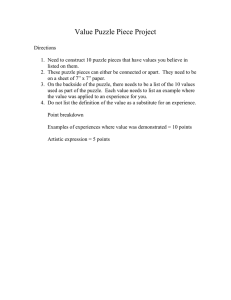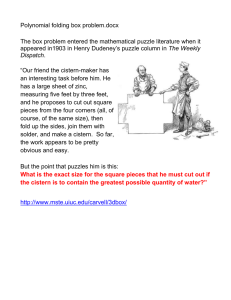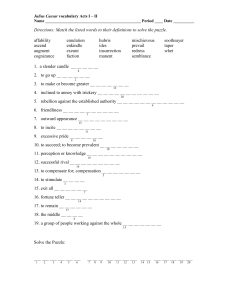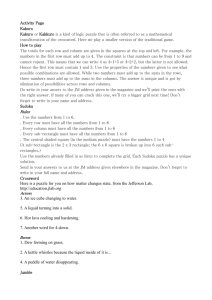Sudoku Solver U lizing Logical Solving Techniques and Recursive Backtracking
advertisement
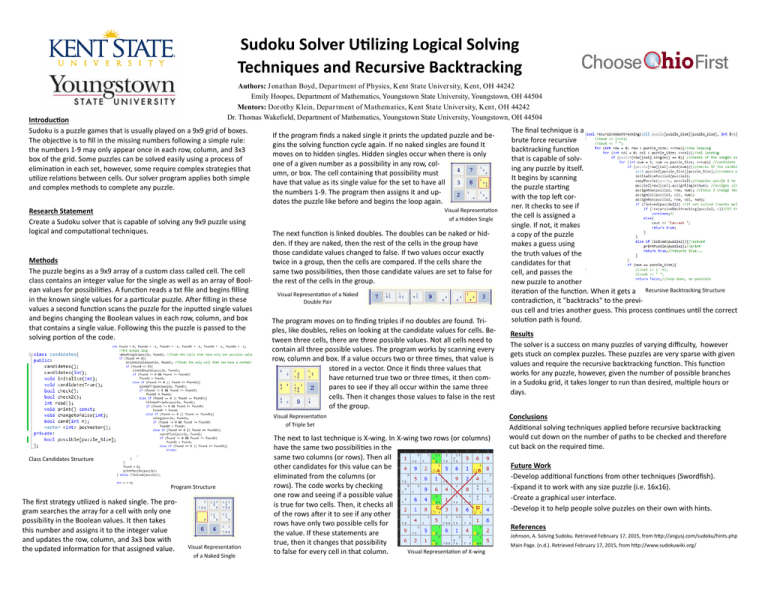
Sudoku Solver U lizing Logical Solving Techniques and Recursive Backtracking Authors: J onathan Boyd, Depar tment of Physics, Kent State Univer sity, Kent, OH 44242 Emily Hoopes, Department of Mathematics, Youngstown State University, Youngstown, OH 44504 Mentors: Dorothy Klein, Depar tment of Mathematics, Kent State Univer sity, Kent, OH 44242 Dr. Thomas Wakefield, Department of Mathematics, Youngstown State University, Youngstown, OH 44504 Introduc on Sudoku is a puzzle games that is usually played on a 9x9 grid of boxes. The objec ve is to fill in the missing numbers following a simple rule: the numbers 1-9 may only appear once in each row, column, and 3x3 box of the grid. Some puzzles can be solved easily using a process of elimina on in each set, however, some require complex strategies that u lize rela ons between cells. Our solver program applies both simple and complex methods to complete any puzzle. Research Statement Create a Sudoku solver that is capable of solving any 9x9 puzzle using logical and computa onal techniques. Methods The puzzle begins as a 9x9 array of a custom class called cell. The cell class contains an integer value for the single as well as an array of Bool-­‐ ean values for possibili es. A func on reads a txt file and begins filling in the known single values for a par cular puzzle. A er filling in these values a second func on scans the puzzle for the inpu ed single values and begins changing the Boolean values in each row, column, and box that contains a single value. Following this the puzzle is passed to the solving por on of the code. If the program finds a naked single it prints the updated puzzle and be-­‐ gins the solving func on cycle again. If no naked singles are found It moves on to hidden singles. Hidden singles occur when there is only one of a given number as a possibility in any row, col-­‐ umn, or box. The cell containing that possibility must have that value as its single value for the set to have all the numbers 1-9. The program then assigns it and up-­‐ dates the puzzle like before and begins the loop again. Visual Representa on of a Hidden Single The next func on is linked doubles. The doubles can be naked or hid-­‐ den. If they are naked, then the rest of the cells in the group have those candidate values changed to false. If two values occur exactly twice in a group, then the cells are compared. If the cells share the same two possibili es, then those candidate values are set to false for the rest of the cells in the group. Visual Representa on of a Naked Double Pair The program moves on to finding triples if no doubles are found. Tri-­‐ ples, like doubles, relies on looking at the candidate values for cells. Be-­‐ tween three cells, there are three possible values. Not all cells need to contain all three possible values. The program works by scanning every row, column and box. If a value occurs two or three mes, that value is stored in a vector. Once it finds three values that have returned true two or three mes, it then compares to see if they all occur within the same three cells. Then it changes those values to false in the rest of the group. Visual Representa on of Triple Set Class Candidates Structure Program Structure The first strategy u lized is naked single. The pro-­‐ gram searches the array for a cell with only one possibility in the Boolean values. It then takes this number and assigns it to the integer value and updates the row, column, and 3x3 box with the updated informa on for that assigned value. Visual Representa on of a Naked Single The next to last technique is X-wing. In X-wing two rows (or columns) have the same two possibili es in the same two columns (or rows). Then all other candidates for this value can be eliminated from the columns (or rows). The code works by checking one row and seeing if a possible value is true for two cells. Then, it checks all of the rows a er it to see if any other rows have only two possible cells for the value. If these statements are true, then it changes that possibility Visual Representa on of X-wing to false for every cell in that column. The final technique is a brute force recursive backtracking func on that is capable of solv-­‐ ing any puzzle by itself. It begins by scanning the puzzle star ng with the top le cor-­‐ ner. It checks to see if the cell is assigned a single. If not, it makes a copy of the puzzle makes a guess using the truth values of the candidates for that cell, and passes the new puzzle to another itera on of the func on. When it gets a Recursive Backtracking Structure contradic on, it "backtracks" to the previ-­‐ ous cell and tries another guess. This process con nues un l the correct solu on path is found. Results The solver is a success on many puzzles of varying difficulty, however gets stuck on complex puzzles. These puzzles are very sparse with given values and require the recursive backtracking func on. This func on works for any puzzle, however, given the number of possible branches in a Sudoku grid, it takes longer to run than desired, mul ple hours or days. Conclusions Addi onal solving techniques applied before recursive backtracking would cut down on the number of paths to be checked and therefore cut back on the required me. Future Work -Develop addi onal func ons from other techniques (Swordfish). -Expand it to work with any size puzzle (i.e. 16x16). -Create a graphical user interface. -Develop it to help people solve puzzles on their own with hints. References Johnson, A. Solving Sudoku. Retrieved February 17, 2015, from h p://angusj.com/sudoku/hints.php Main Page. (n.d.). Retrieved February 17, 2015, from h p://www.sudokuwiki.org/
